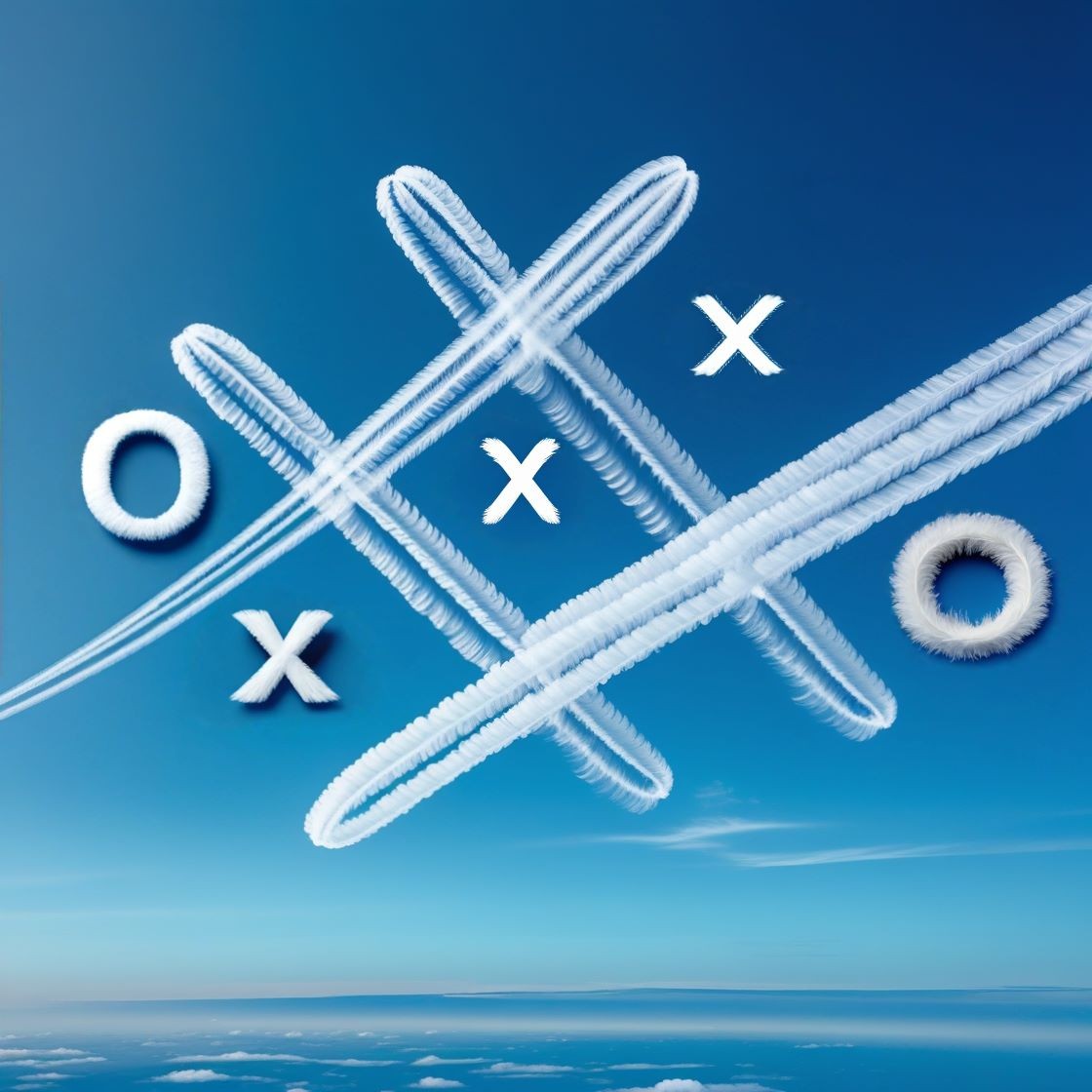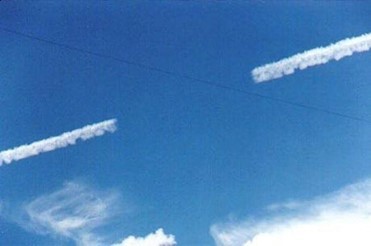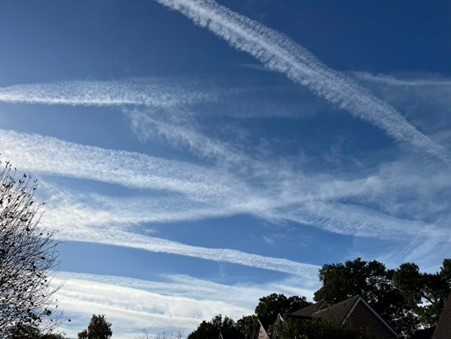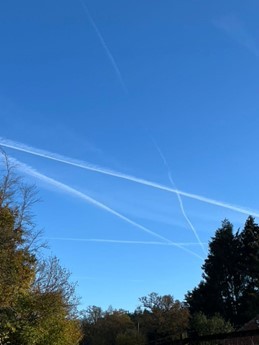
When it comes to conspiracy theories, I’m prepared to approach most with an open mind. I can see, for example, how it could be that the moon landings might have been faked. On the other hand, I just can’t accept the idea that Earth might be flat for I did enough air navigation in my working life as a pilot, and I’d seen enough with my own eyes, to confirm that it is indeed an orb, just as advertised. Likewise, with “chemtrails”. All those trails in the sky were not “chemtrails”, they were contrails, the normal product of the combustion by jet engines of hydrocarbons in the upper troposphere. Of course they weren’t chemicals being sprayed on us to create cloud, dim the Sun, make rain or, worse, poison us and our agricultural produce. Don’t be so silly, you tinfoil hatters, you’ll be giving real conspiracy researchers a bad name.
I had been a professional pilot for 45 years, hadn’t I? I know what a contrail is, I’d been close up to them, flown through them and I’d made many myself. “Chemtrails” are another one of those conspiracy theories that really are a bit “out there”. Nowadays, however, I find I’ve changed my mind. We’ll get to that later but first, let me respond to Part One of John Hamer’s series on chemtrails.
I was going to comment on it but as I read, I realised that any comment I might make could end up being as long as the article itself. The best thing I could do, therefore, would be to come up with an article in response, and the best way to approach it would be to go through what John Hamer had written.
Right at the beginning, Hamer writes that the idea that there are persistent and non-persistent contrails is for the birds. Well, he’s off to a bad start with this; contrails can indeed be persistent or non-persistent. The creation of contrails depends on the temperature and humidity of the air mass that an aircraft is flying through and both may vary locally, in the horizontal and the vertical plane. Not only can contrails be persistent or non-persistent, but they can also stop and start from one moment to the next.
Hamer goes on to say that the phenomenon of trail-covered skies started in 1996. Not exactly. In the early days of aviation contrails were not seen simply because aircraft couldn’t fly high enough but, with the development of fighter aircraft such as the Spitfire, Hurricane and the German Me 109, they could. There are photographs of trailing aircraft high over London and South-East England locked in combat during the Battle of Britain. This was a relatively rare sight but then the USAAF 8th Air Force arrived with its B-17 Flying Fortresses which flew much higher than the RAF’s heavy bombers and, all of a sudden, there were trails all over Europe.
The forecasting of contrail levels became an important part of the Met Officers’ briefs to crews because trails are, well, a bit of a giveaway to defending fighters of an aircraft’s presence. Contrail forecasts were still made in the RAF when I was serving between 1970 and 1989.
In the early years of air travel, piston engine aircraft flew at medium level and had to skirt the highest mountains because they couldn’t fly over them. No trails from them. After WW2, commercial aircraft performance developed rapidly, especially with the dawn of the jet age in the late 1950s through to the mid 1960s. There were De Havilland Comets, Boeing 707s, Douglas DC8s De Havilland Tridents and Vickers VC10s plying the air routes and leaving trails behind them. Then things hit a brick wall with the oil crisis of the 1970s, which was orchestrated by Rockefeller man Henry Kissinger, Claus Schwab’s Godfather. Do I suspect the hand of the Rockefeller Club of Rome and the Rockefeller Trilateral Commission in that? You bet I do. But I digress. The upshot was that the growth of commercial air transport stalled for a while. British Airways or its predecessor companies employed no new pilots for 12 years and the same was generally true for all major European airlines.
Then, in 1987 the game was on again and airline pilot recruitment re-started in earnest. The growth of commercial air transport really took off in the 1990s. There were some small blips due to downturns in the general business cycle but, overall, the trend was upwards over the decade and into the new century. It’s during this time that the phenomenon of the low-cost airline arose as companies such as Ryanair and easyJet copied the business model of Southwest Airlines in the USA. They grew rapidly, competitors joined in, some legacy carriers adopted the ‘low-cost’ model for at least some of their operations or started subsidiary companies in an attempt to muscle into the business of the low-cost sector leaders. The result was a rapid and sustained growth in air traffic leading to the skies appearing to be covered with contrails. That’s why the 1990s are thought to be the time when “chemtrails” started.
Nor is it true that contrails do not occur below 33,000 feet as John Hamer claims. Their formation depends on temperature and humidity and the temperature profile of air masses can vary greatly. A brief and simple explanation of the nature of the atmosphere will help understanding.
In the International Standard Atmosphere, the surface temperature is taken to be +15℃ and the sea level pressure 1013.2 hectopascals (millibars). The temperature lapse rate is 2℃ per thousand feet so at 10,000 feet above mean sea level it is assumed to be -5℃, at 20, 000 feet - 25℃ and at 30,000 feet -44℃ (all to the nearest 0.5℃). The tropopause, when the temperature ceases to fall with increasing altitude, is at 36,090 feet and -56.5℃. In reality, an air mass may be significantly warmer or colder than this and the tropopause may be much higher or lower than 36,090 feet. I have seen temperatures as low as -70℃ and a tropopause down at 31,000 feet. It can be much lower in polar regions. That will bring down contrail levels to well below 33,000 feet.
Air masses are rarely static. They are constantly on the move and the best way to think of them is like an ocean. They are fluid. There will be smooth, steady stretches but there will also be faster, rougher patches like shoals and reefs with vertical as well as horizontal currents, created by the differences in temperature, humidity and pressure. Pilots get information about this in their briefing material which will provide forecast “sheer rates” (the change of wind speed and direction of with altitude), used as a predictor of clear air turbulence which can be sudden and violent.
This is the environment in which contrails occur. There may be quite a wide band of contrail levels, say 5000 feet or so or it may be narrower, only 1,000 to 2,000 feet. The temperature and humidity may promote persistent or non-persistent trails. Non-persistent trails will disappear quite quickly after the aircraft has emitted them and they will usually be gone within a couple of minutes or even less. Persistent trails will last a bit longer but even they have usually dispersed after about an hour.
Flying on long straight tracks in the cruise, pilots frequently pass other airliners coming in the opposite direction above or below them. I have done so countless times. If these jets are trailing, I’d be flying along their contrail and watch it gradually dissipate over about half an hour during which we would have covered around 250 miles. Persistent contrails do not hang around all day, especially when there are strong winds at the cruising levels.
John Hamer quotes surface winds in excess of 20 mph as a cut off for chemtrail operations but in reality, the surface wind would have nothing to do with it. You can have light surface winds with howling gales aloft and some topographical features will produce strongish winds at surface level while all is more calm higher up. It’s the wind at medium and high levels which will be crucial.
As far as the routes which aircraft fly are concerned, they will generally be following Standard Arrival Routes into airports and Standard Instrument Departures. Arriving and departing aircraft will usually be deconflicted horizontally but certainly vertically if the horizontal separation criteria can’t be met. These will be well below any level at which they might produce a contrail. Once in the airways they are no longer as constrained as they once were. With modern navigation equipment, GPS is used so there is no need to fly directly to or from radio navigation beacons which delineated the airways. Pilots are free to fly direct to any point they wish within the area of responsibility of the ATC Centre with which they are communicating and subject to deconfliction with other traffic. The point is that air routes are no longer as rigid as they once were. They will be used for planning purposes but in practice pilots go for short cuts as much as possible to make up time and save fuel. It helps the “bottom line”.
Hamer writes that aircraft emitting contrails are constrained by FAA (US Federal Aviation Authority) regulations. Not in the UK and the EU. The Civil Aviation Authority (CAA) does in the UK and the European Union Aviation Safety Agency (EASA), with which the CAA has a Bilateral Agreement, does in the EU.
In the article there is this photograph which is captioned “What a giveaway. Short of switching off the engines for a second, how else would this effect be achieved?”

To which I answer: By photo-shopping it. Why do I say that? Just look at the abrupt ends of the trail. Aircraft have significant slipstreams, the bigger and heavier the aircraft, the more powerful the slipstream. That would attenuate and taper the end of the trail if it has originated from a spraying head because anything sprayed is not thrust out rearwards from the hot core of an aero engine at several hundred miles an hour.
He goes on to discuss the chemicals that might be drifting about to make it rain, dim the sun or poison us. He makes claims that some people have correlated chemtrails with respiratory illness and flu-like symptoms, but he doesn’t say who or what organisations did the collecting and analysis of samples and what their credentials might be. Without that information and verifiable references this is nothing more than speculative hearsay.
All that said, as I stated above, I no longer believe chemtrails are just a crackpot conspiracy theory. After listening to a couple of podcasts about the claimed activity in our skies I decided to do a bit more looking up and make some casual observations. They quite quickly bore some fruit. One evening last summer while driving home from a day’s fishing trip, I saw three trails quite close to each other with another two which crossed them at an angle. The curious thing about the second pair of trails was that they appeared to be above, well above, the first three. This was confirmed by the ‘sightline spin’ of the first three trails. An explanation: “Sightline spin” is an old air force expression which describes the change in the angle of one’s line of sight to an airborne target. A target at a distance would appear to move across the windscreen at a slowish rate. A target closer in would appear to move across much faster so the angle of one’s line of sight to it would change more rapidly. This is what I observed with the first three trails that evening. They were clearly much lower than the second pair which I could also see were dissipating whereas the first three were not.
This led to me watching the sky above my house, particularly early in the morning and in the evenings. On several occasions there were trails which I could see using my old aviator’s eye were below the altitudes that I would expect contrails. I estimate that they were between 10,000 and 20,000 feet. What I never saw was the aircraft that left them there. Here’s a picture of one morning with trails at medium altitude in a sector of the sky at my home in which airliners are not usually present. This was not normal.

The thing to notice about these is how spread they seem to be and feather-like or fish-bone-like appearance. Now here are some normal contrails. You can see how thin they are compared to the ones above.

So, what do we know for sure. We know that weather modification flights were being conducted during the Second World War. It would give enormous military advantage to one side of a conflict if the weather could be modified or at least controlled to some degree. We know that between 1948 and 1952 the RAF conducted Project Cumulus and that during on 15th Augus 1952 there was a catastrophic flood at Lynmouth in Devon during which 34 people died. Nine inches of rain fell in 24 hours. Was the rain a product of Project Cumulus? The Air Ministry and later the Ministry of Defence denied it. We know too that cloud-seeding is done in the Middle East to generate rain and that is what probably happened last year at Dubai when there was unusual rainfall. We know too that last winter and in the early spring there was an inordinate amount of rainfall over Southern England which prevented many farmers from planting their crops.
We also know what retired Army General Jonathon Riley wrote in TCW last year. He produced a four-part series entitled What Are They Doing to Our Skies. It’s a very comprehensive examination of what is going on with links. I would have been unable to add anything to it which is why I haven’t produced a series for FSB. You can read Part One here, Part Two here, Part Three here and Part Four here.
Freedom of Information Requests have been made to the Government, but they were 11 and 12 years ago and they met with denials. You can read them here and here. More recent ones have so far not been answered.
So, who is doing it and where are the aircraft flying from? It won’t be from a major airport, and it won’t be normal commercial flights that are involved in this. The places to look are the smaller, quieter regional airports. One company that might bear examination is 2Excel Aviation. This is a “high performance aerospace service group that specialises in doing difficult things well”. The company operates Coast Guard aircraft and offers VIP charters. Among other things, if you click on Special Missions, you’ll find this.

It offers aerial dispersant services. 2Excel Aviation has two Boeing 727s tri-jets (pictured) which are modified with spraying equipment, ostensibly for oil-spill dispersal operations world-wide. Their registrations are G-OSRA and G-OSRB and they are based at Southend airport. Are they being used for aerial spraying? It’s far from beyond the bounds of possibility. Not living near Southend I can’t keep tabs on the movements of these aircraft but someone who lives nearby and has Flightradar24 installed on a device could easily do so. They should be trackable whenever they take to the skies and a profile of their flights obtained. Two other companies I had in mind, Air Contractors and FR Aviation did not have websites that I could find with any relevant information on them.
That’s it for now except to say I’m looking forward to Parts 2 and 3 of the John Hamer story on chemtrails and depending on what I read I may do another article.